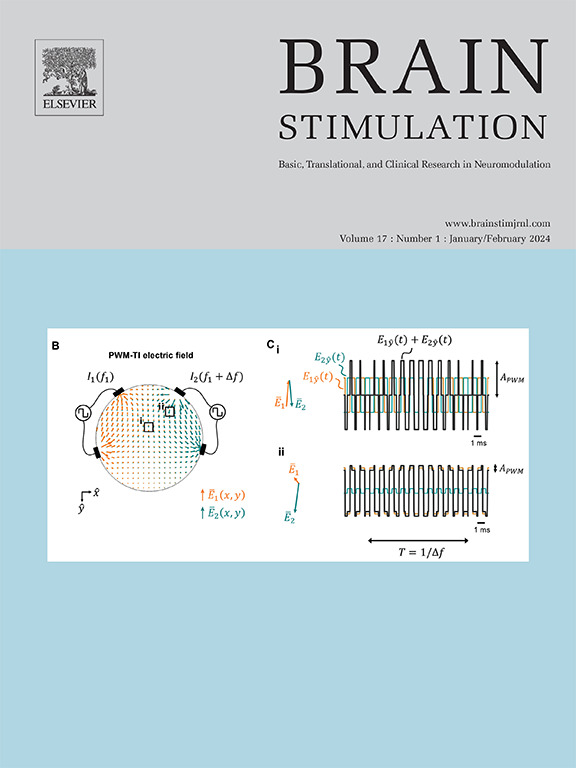Personalized models of Beam/F3 targeting in transcranial magnetic stimulation for depression: Implications for precision clinical translation
IF 7.6
1区 医学
Q1 CLINICAL NEUROLOGY
引用次数: 0
Abstract
Background
Clinical transcranial magnetic stimulation (TMS) for depression routinely relies on the scalp-based Beam/F3 targeting method to identify stimulation targets in the dorsolateral prefrontal cortex (dLPFC). Scalp-based targeting offers a low-cost and easily implemented method for TMS coil placement, enhancing treatment availability. However, limited anatomical and functional specificity of the Beam/F3 method may affect treatment outcomes, motivating assessment of the clinical standard.
Methods
In a naturalistic clinical trial of TMS conduced at four Veterans Affairs hospitals, the authors evaluate the Beam/F3 method using neuroimaging incorporated before TMS, after five treatment sessions, and after all thirty sessions. Personalized anatomical and electric field (E-field) models were developed to assess target location and network engagement, as well as subsequent effects on clinical outcomes.
Results
Anatomical models demonstrate that the Beam/F3 method produced reliable targets in the dLPFC across individuals and repeated treatment sessions. E-field models revealed that baseline anticorrelation between the stimulation center and the sgACC was associated with antidepressant symptom response after five TMS sessions () and at the end of treatment (). Relatedly, E-field magnitude at the sgACC-anticorrelated peak in the prefrontal cortex correlated with symptom response throughout treatment (early treatment: ; end of treatment: ).
Conclusions
This work establishes that scalp-based targeting can produce reliable targets in the dLPFC and be successfully evaluated using a combination of neuroimaging and E-field modeling in pragmatic, multisite applications. Importantly, this investigation also found that significant network effects occur early in treatment and that Beam/F3 targets can engage functional mechanisms in TMS.
BeamF3靶向经颅磁刺激治疗抑郁症的个性化模型:对精确临床翻译的意义。
背景:临床经颅磁刺激(TMS)治疗抑郁症通常依赖于基于头皮的BeamF3靶向方法来识别背外侧前额叶皮层(dLPFC)的刺激靶点。基于头皮的靶向为TMS线圈的放置提供了一种低成本和易于实施的方法,提高了治疗的可用性。然而,BeamF3方法有限的解剖和功能特异性可能会影响治疗结果,促使临床标准的评估。方法:在四家退伍军人事务医院进行的经颅磁刺激自然临床试验中,作者利用经颅磁刺激前、5次治疗后和30次治疗后结合的神经成像来评估BeamF3方法。开发了个性化的解剖和电场(E-field)模型来评估目标位置和网络接合,以及随后对临床结果的影响。结果:解剖模型表明,BeamF3方法在个体和重复治疗过程中产生了可靠的dLPFC靶点。电场模型显示,刺激中心和sgACC之间的基线反相关性与五次经颅磁刺激后()和治疗结束时()的抗抑郁症状反应有关。与此相关的是,在整个治疗过程中,前额皮质sgacc -反相关峰的电场大小与症状反应相关(早期治疗:;治疗结束:)。结论:本研究表明,基于头皮的靶向可以在dLPFC中产生可靠的靶点,并且可以在实用的多位点应用中使用神经成像和电场建模的组合成功评估。重要的是,本研究还发现显著的网络效应发生在治疗早期,并且BeamF3靶点可以参与经颅磁刺激的功能机制。
本文章由计算机程序翻译,如有差异,请以英文原文为准。
求助全文
约1分钟内获得全文
求助全文
来源期刊

Brain Stimulation
医学-临床神经学
CiteScore
13.10
自引率
9.10%
发文量
256
审稿时长
72 days
期刊介绍:
Brain Stimulation publishes on the entire field of brain stimulation, including noninvasive and invasive techniques and technologies that alter brain function through the use of electrical, magnetic, radiowave, or focally targeted pharmacologic stimulation.
Brain Stimulation aims to be the premier journal for publication of original research in the field of neuromodulation. The journal includes: a) Original articles; b) Short Communications; c) Invited and original reviews; d) Technology and methodological perspectives (reviews of new devices, description of new methods, etc.); and e) Letters to the Editor. Special issues of the journal will be considered based on scientific merit.
 求助内容:
求助内容: 应助结果提醒方式:
应助结果提醒方式:


